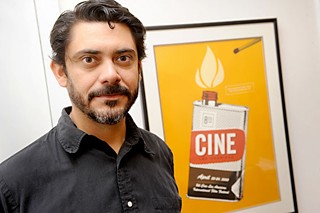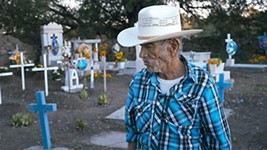On the Scene With Cine Las Americas
The festival director talks about finding international emerging voices and programming in the age of piracy
By Dan Solomon, Fri., April 12, 2013
As the Cine Las Americas Film Festival enters its 16th year, it's grown into a place where it's able to serve multiple roles – as both a cultural institution for Austin's sizable Latin American population and a film festival that stands on its own artistically in a town that often seems to be on the verge of being overrun by film festivals. As the festival matures, so too has the way in which it balances those two goals. This has been made easier by the fact that the fundamental role of a festival that screens international movies has shifted in an age when most popular films, no matter where in the world they come from, are available to download (either legally or illegally) on the Internet. Combine that with the access that younger filmmakers – who have historically lacked some of the necessary resources to make a film – now have to equipment that fits in their pockets, and there's potential for a new moment in Latin American film. We caught up with Cine Las Americas Executive Director Eugenio del Bosque to talk about the risks he's able to take in programming, looking for emerging voices in countries like Peru and Guatemala, and why female filmmakers are especially keen to take advantage of these new opportunities.
Austin Chronicle: How do you balance the goals of serving a cultural role as a meeting place for the communities who are stakeholders in the festival with the artistic goals of putting on a film festival full of challenging films?
Eugenio del Bosque: A lot of times in the U.S., especially years ago, it was easy to be isolated up here ... if you weren't part of the salsa group or the cultural groups. When it comes to cinema, the Latino festivals in the U.S. have always been very good at representing the culture, while we are all about the movies. Of course, culture goes hand in hand, and while diversity is a principal part of our mission, we're also about artistic excellence in film. Over the years, we've been able to build an identity that has just as much to do about film. We take risks programming. We can show some things that are not commercially viable, or not in full agreement with idea of Latino identity that people may have. And the Austin audience also knows that. It's a young audience, and it's a morphing audience all the time. ... So we're able to bring to the screen things that are not commercial, or easy to follow, or not expected of an audience-based festival, which is ultimately what we are. Because we're in Austin, we're able to take these kinds of risks ... and we have been able to come to the synchronism of diversity and artistic excellence.
AC: Does focusing on artistic excellence carry other benefits?
EdB: There are hundreds of films being made in several different countries in Latin America. Mexico, Chile, Brazil – there's so much stuff coming out at so many different levels. You read your Sundance, your Berlin, your Cannes, even, and they're winning. There are big movies, there are medium-sized movies, there are art movies, there are commercial movies. There are so many films that are deserving of screen time. ... At the end of the day, what we've centered on together are cultural issues, but what we try to do is not give the spotlight for the issues, but to say that this has the merit of its art, as a film. But of course, along with that, the cultural fabric is what brings the people. We get the cinephiles, and that's something that's very important for us – that you can trust us if you're a cinephile. It's not a film made by Mexicans for Mexicans; it's a film made from a filmmaker, for people who like film. But at the same time, you're going to get, for example, something Chilean on the screen. We get the Chilean community, and half of them hate it, because it's not the big thing that they've been reading about, the one movie that's becoming famous that they want to see. And it may have an artistic treatment that they're not comfortable with.
AC: In the past, if people wanted to see a movie that was popular in Chile that wasn't playing a festival, they had to travel and bring back a copy of it, or maybe order it from a video store that would hopefully be able to get a copy. Now, people can download almost everything. Does that change how you program the festival?
EdB: I've heard so many different things about what downloading does to a movie. From producers saying, "Well, at least it's being seen," to other opinions, from theatre owners and programmers who are breaking their heads because you always have to be creating an event around a movie. So that's relative. I think a good program can hold itself. One of the most interesting things I've heard is when people are calling us, asking: "When is it coming? Are you bringing it? ... Because we can't find it anywhere to download." So it just creates more buzz, I suppose. I don't know if people who download will still go to the theatre to see it. ... But what I do know is that stuff we're showing is probably not even available for download. It's still too new.
AC: Has the fact that the technology to make a movie has gotten much cheaper changed the type of movies that you see at the festival?
EdB: Big time, yeah. There's a lot of on-the-go. That's something interesting about these countries that are so prolific right now. ... A lot of it is becoming very hipster, if you will – that digital concept that [Robert] Rodriguez championed, that get-up-and-go and do it. Sometimes it works and sometimes it doesn't. Thin scripts, very thin storytelling, lots of pretty photography. Guys in love photographing the girls. The guys are especially prone to just telling you a vague story because pretty stuff is going on. The women directors are more interesting, when it comes to "grab a camera and make a movie." We always try to keep an eye on that – part of diversity is keeping women on the slate and finding women directors. It's not easy – this year it has been more difficult to find women directors. But there's a lot of respectable work by women. The funny thing is, being from such apparently male-dominated cultures, women filmmakers have a completely different voice. It's very fresh. It's always very good to see their side of stories.
But there's a lot of that – lots of film school work, a lot of indie stuff – that can be thin on the writing, or the art direction sometimes, so we have to be very careful about curating that, because there are valuable stories being told, and there may be new voices emerging because of that, or stylistic and aesthetic trends coming out of the whole thing. ... So we have to keep a good eye.
AC: Is it possible for an aspiring filmmaker in Guatemala to just grab a camera and make a movie now?
EdB: I think it's possible. The tricky part is what's informing them, especially aesthetically. There's a misunderstanding that Latin American audiences are primarily informed by telenovelas. I think it's a half-truth. I think most people are influenced by Hollywood. That's what you see in the multiplex down there, mostly. Most movies are not being shown on the screen in their country of origin. There's no opportunity, because the multiplexes are owned by Hollywood. It's not always like that, and there are art spaces and alternatives – though maybe not in every country. But now there are so many different things going on, and so many different ways to convey your message. You can shoot it on your phone, you can watch it on your phone. You can shoot it with a big camera. But at the end of the day, you're using the same language. You're shooting a shot, you're editing a shot, you have a sequence. That stuff is still the same. There are many different clever ways to present, and there's room for innovation, yet I think it also has a lot to do with the possibility of looking in the mirror and being introspective about what's making you do those things. That's what I like about that approach, when you see people just grabbing it and going and doing it – it's very outgoing. They're not afraid.
The Cine Las Americas International Film Festival runs April 16-21 at the Stateside at the Paramount (719 Congress), Alamo Drafthouse Village (2700 W. Anderson), the Emma S. Barrientos Mexican American Cultural Center (600 River), and St. Edward's University (3001 S. Congress). See the festival website, www.cinelasamericas.org, for the full lineup and ticketing information.












